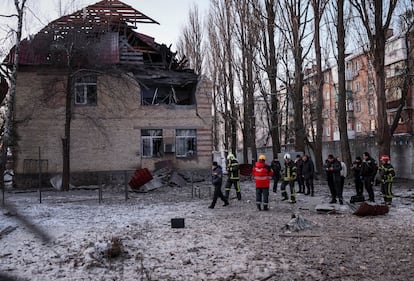Russia steps up suicide drone campaign against Kyiv
Air defense systems around the capital shot down over a dozen Shahed unmanned vehicles as Western allies pledged €1 billion in aid to patch up Ukraine’s power grid

Russian air strikes targeted Kyiv again on Wednesday morning as Moscow launched a fresh wave of attacks using Iranian-manufactured Shahed 131 and 136 drones. Over a dozen of the devices were sent on a raid into the province containing the Ukrainian capital, but the majority were shot down by air defense systems, according to sources from the Ministry of Internal Affairs. There were no casualties caused by Russia’s latest attempts to knock out the power supply in Kyiv, but one government building and several residential blocks were damaged. The strike was carried out with the same drones Moscow has deployed on numerous occasions during the war in Ukraine dubbed suicide or kamikaze drones, these unmanned vehicles are packed with explosives and destroyed if they reach their objective, but they are also easier to detect and intercept than missiles.
The latest wave of drone strikes was launched from the Sea of Azov, according to the High Command of the Armed Forces of Ukraine, covering hundreds of miles over Ukrainian airspace before reaching the capital. Local television provided footage of damage to the lower floor of a residential building and the wreckage of the drone that caused it, on which was inscribed a message in Russian: “For Ryazan,” one of the strategic bomber bases deep in Russian territory targeted by attacks on December 5.
Last Saturday, Russian air strikes targeted the province of Odesa in southern Ukraine, leaving up to a million and a half people without electricity. In plummeting temperatures, local authorities said it would be impossible to repair the damage entirely in the short-term, stating that it could take several months. Following calls from Ukrainian President Volodymyr Zelenskiy for emergency assistance to patch up the country’s power grid to ensure Ukrainian citizens have access to basic utility services through the winter, Kyiv’s allies approved €1 billion in aid at a conference in Paris on Tuesday.
Moscow’s Shahed drones have a range of up to 2,000 km (1,240 miles) and are a considerably cheaper weapon than missiles, although they are far less accurate and carry less destructive power. They have a top speed of around 180 kmph (110 mph) and their engines alert defenders to their approach before they reach their targets. As such, Shahed drones – so baptized because the word translates from Farsi to “martyr” – are easier for Ukrainian air defense batteries to track and shoot down. According to Ukraine’s secret services, Moscow has acquired 2,400 Shahed drones from Tehran.
Zelenskiy has also called on Kyiv’s allies to strengthen Ukraine’s anti-aircraft capabilities to provide more firepower against massive drone attacks so they cause fewer causalities and less damage to infrastructure while also reducing Russia’s strike capabilities due to the huge cost to the Kremlin of employing cruise missiles.
Ukraine’s power grid and energy infrastructure are currently in a critical situation following a sustained campaign launched in October by Moscow designed to cause suffering for the civilian population by cutting off supplies of water, electricity and gas. To date, there have been a dozen large-scale drone and missiles attacks across Ukraine, causing serious damage to the country’s essential infrastructure.
The latest strikes come after the December 5 attacks against Russian airbases hundreds of miles beyond the Ukrainian border, which Russian media have attributed to Kyiv. In the 10 months since the Kremlin ordered a full-scale invasion, it was the first time military installations inside Russia had been attacked, causing damage to Su-95 strategic bombers housed at airbases in the regions of Saratov and Ryazan. The following day, several fuel depots were set ablaze at both the Kursk airfield and an industrial plant in Bryansk, in regions bordering Ukraine. Local sources confirmed to Politico that these attacks were carried out using Soviet-era drones that have been modified by Ukraine’s military.
Sign up for our weekly newsletter to get more English-language news coverage from EL PAÍS USA Edition
Tu suscripción se está usando en otro dispositivo
¿Quieres añadir otro usuario a tu suscripción?
Si continúas leyendo en este dispositivo, no se podrá leer en el otro.
FlechaTu suscripción se está usando en otro dispositivo y solo puedes acceder a EL PAÍS desde un dispositivo a la vez.
Si quieres compartir tu cuenta, cambia tu suscripción a la modalidad Premium, así podrás añadir otro usuario. Cada uno accederá con su propia cuenta de email, lo que os permitirá personalizar vuestra experiencia en EL PAÍS.
¿Tienes una suscripción de empresa? Accede aquí para contratar más cuentas.
En el caso de no saber quién está usando tu cuenta, te recomendamos cambiar tu contraseña aquí.
Si decides continuar compartiendo tu cuenta, este mensaje se mostrará en tu dispositivo y en el de la otra persona que está usando tu cuenta de forma indefinida, afectando a tu experiencia de lectura. Puedes consultar aquí los términos y condiciones de la suscripción digital.
More information
Archived In
Últimas noticias
Welcome to the post-religion era: The idea of Christianity as the absolute truth has become obsolete
‘I thought you would like it’: The risky sexual practice popularized by TV shows and TikTok
The digitalization of tourism: ‘They promise experiences and gave us the worst possible one’
Mexican peso defies uncertainty with forecasts of a new period of stability in 2026
Most viewed
- Sinaloa Cartel war is taking its toll on Los Chapitos
- Reinhard Genzel, Nobel laureate in physics: ‘One-minute videos will never give you the truth’
- Oona Chaplin: ‘I told James Cameron that I was living in a treehouse and starting a permaculture project with a friend’
- Why the price of coffee has skyrocketed: from Brazilian plantations to specialty coffee houses
- Silver prices are going crazy: This is what’s fueling the rally










































